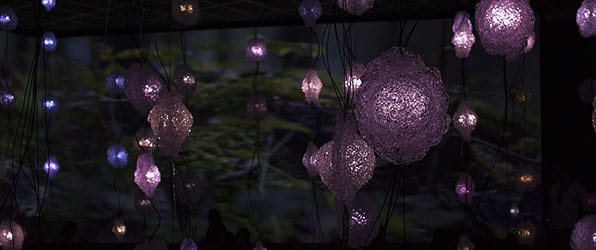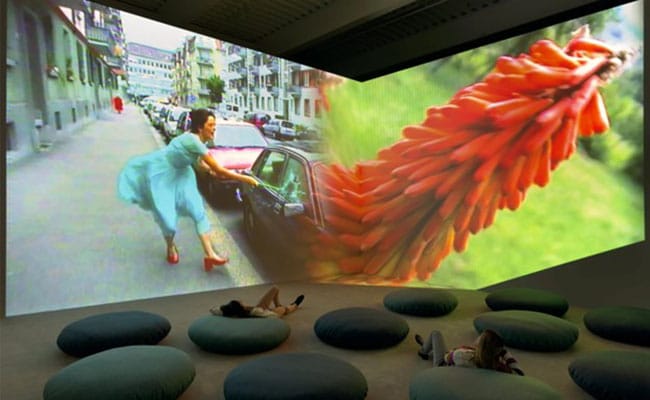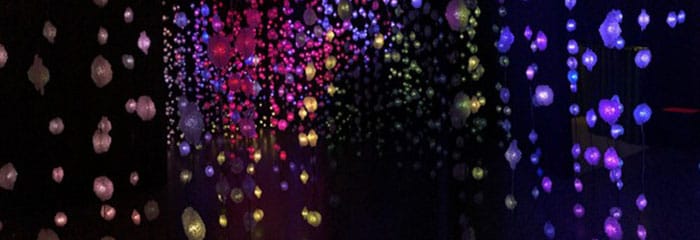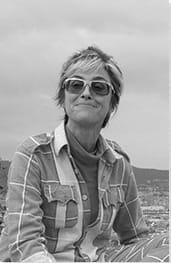Summary of Pipilotti Rist
Rist has garnered international acclaim for her immersive multi-channel and spatial video installations. She is often discussed as the heir-apparent to the founding father of Video art, Nam June Paik, but Rist has done more than her predecessor to overlap the worlds of contemporary art and mainstream culture. Rist's lush and seductive imagery alludes to the worlds of advertising and music videos, but she brings to this a highly individualistic artistic language. Following her oft-quoted analogy between the disorderly content of her video work with that of the inside of a woman's handbag, she brings together the worlds of music, painting, technology, movement, humor, and poetry in a way that has the power to entrance her viewer. Rist's stated aim is to help her followers adopt a more benign view of their world in the belief that positive changes in attitude toward each another can be best achieved through a combination of thought and feeling.
Accomplishments
- Rist made her first impression on the contemporary art scene through her single and multi-channel video works. Her early music and performance videos, such as I'm Not The Girl Who Misses Much (1986), have been widely interpreted as ironic commentaries on the representation of women in the age of MTV. While it is clear to see why they have been interpreted as such (and even though Rist claimed at the time never to have seen MTV), her work of this period also invites parallels with the pioneering Performance and Installation artist, Laurie Anderson (who had herself brought contemporary art into the commercial arena of MTV).
- Moving on from her single and multi-channel works, Rist projected her videos into the exhibition space. It marked a decisive shift in her focus towards immersive installation art that promised "hypnotic" and "transformative" experiences. Viewers for Sip My Ocean (1996), for instance, were placed in a spellbinding, hallucinogenic-like, conjunction of the natural and technological worlds. Rist states that her aim was to create works that act "like a lullaby" and which provide a gallery environment where "worry will vanish".
- In her mature practice, Rist has pushed her immersive installations even further by placing the viewer, as it were, "within her screen". 2016's Pixel Forest saw Rist "enfold" her viewer within 3,000 thousand resin encased LED lights. The effect, which is something akin to a television screen that has exploded and reached into the exhibition room itself. Rist's installation affords the viewer the impression they are walking through a 3-dimensional video of their own and they are able to "embrace the poetic in the electromagnetic overflow" of the experience.
- In an attempt to reach the widest audience, and, in her words, "to break down the class struggle between the type of people who visit museums and those who never put a foot inside one", Rist expanded her repertoire into feature film production. Although not commercially successful, Pepperminta (2009), is a surrealistic fairy tale with the titular character acting as Rist's alter-ego; that is, a bold, compassionate, and independent young woman on a quest to invent striking color combinations that will free people from fear and make their lives better.
The Life of Pipilotti Rist

Marc Payot, president of the Hauser and Wirth gallery, states, "The miracle of Pipilotti Rist is that she uses the camera with the same impact that the greatest painters have achieved with a brush [She recreated] a whole new form of expression, an ingenious cosmos all her own. But at the same time, her work is brimming with so much generosity that it engages every kind of viewer".
Important Art by Pipilotti Rist
I'm Not the Girl Who Misses Much
This five-minute, single-channel video (a video artwork exhibited on one playback device/screen) was Rist's first significant work. Made while she was still a student, it brought her early recognition in the world of experimental video art. Rist wears a black dress, which leaves her breasts exposed, and dances in an empty white space in front of the camera. She repeatedly sings: "I'm not the girl who misses much". It is the first line of the Beatles' 1968 song "Happiness Is A Warm Gun" (written by John Lennon about Yoko Ono, both of whom were important early influences on Rist). Arts writer Natasha Bullock called the work "a raunchy, fast-paced video that depicts a woman's yearning".
The audio and video are alternately speeded-up and slowed-down while monochromatic red and blue color filters are applied to some portions of the video. Moreover, as the video progresses, the image becomes increasingly distorted, "glitchy", and fragmented. Rist explains that her choice to alternate between different speeds "is for me an exorcistic dance. When I present things in slow motion, I would say that's 'reality', because our perception of time is subjective. When you're nervous, a half hour can feel like an eternity, and when you're feeling contemplative, it goes so fast. So time is extremely relative".
Curator Rachel Taylor explains that when this work was first shown, it "was interpreted by critics as an ironic comment on the representations of women on the popular music video station MTV. By appropriating and wittily subverting the language of music video, Rist was seen to be making a feminist response to the often slick, sexist images on the channel. Rist has denied seeing MTV before making the work, but her use of popular music and technical fluency with the video medium suggest parallels with pioneering experiments on the station by artists including Laurie Anderson".
Video, monitor, color, and sound - The Tate, London, England
Pickelporno (Pimple Porno)
Pickelpornowas an early attempt by Rist to create a work of "feminist porn", focusing in on female pleasure. In it, the camera pans, in close-up, over the bodies of two lovers. Art critic Calvin Tomkins explains that Rist, "Instead of looking at sexual encounters from the outside, [...] wanted to convey what the participants were feeling and seeing. Using a tiny surveillance camera designed to be hidden in walls, she worked very close, filming random moments of a nude couple's imaginative foreplay - fingers exploring body parts, a hand caressing a breast, an erect and friendly penis. She interspersed these with shots of clouds and palm fronds, a lake, a miniature globe of the world resting on a vulva, and extended tongues, set to a soundtrack of rushing and bubbling water and ardent moaning". Curator and arts writer Natasha Bullock describes how "the fragmented action reaching fever-pitch in the form of an erupting volcano".
Other female artists working around this time took up the theme of pornography in their work, such as South African Candice Breitz, who created monstrous figures in her controversial 1996 Rainbow Series by collaging cut-up women's bodies from porn magazines and tourist postcards, critiquing the fetishization of both porn actresses and stereotyped representations of "African" women. But, as Tomkins notes, Pickelporno "offended no one [and] it even appeared on Swiss television". Says Rist, "My theory with [Pickelporno] was that women - and I am not even sure you can really generalize that broadly - may be more interested in knowing what the other is feeling and thinking than in seeing the action as a third person from the outside. [...] When you watch sex from the outside, it is always much less interesting than when you are involved in it".
Video (color, sound) - Museum of Modern Art, New York, New York
Sip My Ocean
This audio-video installation work, which took over two years to produce, was Rist's first exploration into creating an "immersive" experience by using video projections instead of monitors. In it, she presents scenes shot underwater (in Egypt's Red Sea), with a wide-angle lens, of herself and her friend and collaborator Pierre Mennel swimming, floating, and rolling in the sea. Other shots show objects, like a television, a toy heart, and teacups, sinking slowly beneath the water's surface, as well as roses superimposed over shots of the sky. The video is projected as a mirror image of itself onto two adjoining walls, creating a visual experience that recalls Rorschach tests or kaleidoscope images, and which gives the viewer the feeling of being immersed in an aquatic world. Early in her career, Rist explained, "I like installations that really get you involved, that make you part of them, or that even work like a lullaby. When I do projections, I want people to go inside them so that colours, movement, pictures are reflected on their bodies". Sip My Ocean is perhaps the work in which she best realizes that goal.
The audio track for Sip My Ocean was composed by Rist's friend, ex-boyfriend, and former neighbor, Anders Guggisberg, and features Rist repeatedly singing/screaming "I don't want to fall in love with you" (a line from the 1989 pop song "Wicked Game" by Chris Isaak). Rist has explained that this work "is about the deep fear of desire" and that her intention was for it to evoke "the glory of life, [where] worry will vanish". Bullock writes of Sip My Ocean, "sexually suggestive of the body, its title characteristically fuses the intimate self with the world, personifying nature and, at the same time, broadly acknowledging that we too are animals within this cosmos. [...] With its hallucinogenic visual mirroring, colour and lyrics, it describes the impulses of desire. It is a serenade about an impossible wish to not fall in love again and to be in synchronicity with the other".
Klaus Biesenbach, director of the Neue Nationalgalerie in Berlin, stated Sip My Ocean "changed my curatorial practice [...] I looked at videos differently after seeing it, and I looked at color differently". Video artist Joan Jonas (whom Rist cites as an influence) also admired the work, even showing it to students in her classes at the Massachusetts Institute of Technology. Says Jonas, "The lightness, motion, weightlessness, gravity, melancholy, and levitation" seemed to remind students "of flying carpets, winged horses, genies, [and] carousels".
Single-channel color video installation, shown using two projectors, with sound - Solomon R. Guggenheim Museum, New York, New York

Ever Is All Over
As with Sip My Ocean, Ever Is All Over was made to be projected onto two adjoining walls. In the video on the left, a woman (Swiss filmmaker Silvana Ceschi) is seen in a blue dress, walking down a city street, smiling, and gleefully smashing the windows of parked cars with an iron rod painted to look like a long-stemmed flower. At one point, a female police officer approaches her, but rather than arrest her, she greets her with a smile and a wave and goes on her way. Other passers-by (one of whom is Rist's mother, and another, her brother Tom) simply ignore Ceschi. This left-hand video is juxtaposed with the right-hand video, which shows a series of images of landscapes and exotic flowers. According to Rist, the video is "honouring nature, by exaggerating the power of a tender, fibrous plant". The work was shown publicly for the first time at the 1997 Venice Biennale where it won the Premio 2000 award for emerging talent. Art critic Calvin Tomkins asserts that "It is one of those rare works whose elements - hilarity, suspense, timing, comic violence, anarchy, and a lovely musical score - fit together with irresistible perfection".
Visual artist, and arts administrator Ted Snell calls Ever Is All Over"a vivaciously feminist call to arms" and argues that Rist manages to play the role of a "joyfully anarchic figure, a wonderfully mischievous girl/woman grasping a flowering phallus and delivering well-timed blows to authority while remaining triumphantly graceful and elegant". Says Snell, "Her carefree manner draws us along for the ride, and we happily join with her in her rampage. It is surprisingly liberating and, yes, amazingly joyous! [...] The environment it creates is embracing, welcoming and it encourages our complicity. It is luscious, intense and alluring, like so much of her work, presenting us with a world that is aesthetically heightened and very seductive". Global music icon, Beyoncé, payed homage to Ever Is All Over in her 2016 music video, "Hold Up", in which she smashes car windows with a baseball bat. Says Rist, "Pop music opened a window on Yoko Ono and the art world for me, and I'm glad to give something back. I would have preferred that Beyoncé did it with a flower and not a baseball bat, because it changes the meaning. But, no, I was very flattered".
Audio video installation - Museum of Modern Art, New York
Pepperminta
In 2009, Rist made a feature-length film, Pepperminta, which premiered at the 66th Venice International Film Festival. The film, shot from low angles, giving the viewer the sense of looking at the world from a child's point of view, follows the titular character (whom film critic Boyd van Hoeij calls "a modern-day Pippi Longstocking") and her friends, who, as Rist explains, are "on a quest to find the right color combinations and with these colors they can free other people from fear and make life better". Evidently, the bold, fun-loving, and independent Pepperminta (played by Polish actress Ewelina Guzik), is a sort of alter-ego for Rist. Guzik has stated that the experience of participating in the film was "like being on a trip but you don't need the drugs". She added that working with Rist taught her a lot about basic compassion, noting that the artist "is so deeply concerned about everybody working around her - and probably also for everyone else in the world. It's a big part of what her work is about".
Art critic Emily Watlington argues that this stylistic choice "conveys an implicit feminist statement: women are often dismissed as being jejune in order to justify excluding them from positions of power". Watlington adds that "Color, too, has historically been considered 'feminine,' unserious, distasteful, or superficial within art circles", and that, with this film, as in many of her other videos, "Rist is reclaiming a firmly feminine aesthetic". Commenting, however, on the film's mixed reception, Van Hoeij wrote in his review of Pepperminta, "Unafraid of show-stopping interludes, gaudy production design, dizzying camera movements and edits, and omnipresent music, Rist pulls out all the stops. Result will be endearing to some and make others run for the hills". For her part, Rist stated she simply wanted to reach "a new audience via cinema and television in order to break down the class struggle between the type of people who visit museums and those who never put a foot inside one".
Film

Pixel Forest
One of Rist's most famous works, which she has recreated several times in various venues and with different titles since 2016, Pixel Forest is an immersive installation. It features not only video and audio, but also a "forest" of 3000 colored, orb-shaped LED lights, strung along plastic cables that hang like vines from the ceiling, and under which viewers are encouraged to walk. The floor is shiny and black, reflecting the lights above, and thereby making the "pixel forest" appear almost infinite. Bullock writes that "The work imagines a television monitor exploding into a room, referencing how images on a screen are made from hundreds of pixels. [...] Each sculptural LED is operated by a separate video signal that reacts to music in the corresponding exhibition spaces. Together, these signals create a sequence and if we could stand far enough away from the work we would be able to see a complete image. The floating pixels are ever changing, with sequences of light that twinkle or surge like a wave of vibrant colour in response to the music".
Rist was inspired to produce the work after trying on a set of virtual reality goggles. She was impressed with the technology, and the way it recreated a sensory three-dimensional experience, but she felt that it had also left her feeling "extremely lonely". Rist called her installation a "rough, raw virtual reality" in which her viewers were invited to touch and explore their immediate surroundings. On the one hand, the installation allowed the viewer to imagine themselves inside their computer or phone. But the work also carried a deeper resonance in the way it commented on how easy it is to become lost in digital technology.
Arts writer Jessica Klingelfuss cites the work as an example of the way in which "The healing power of art is a quiet thread in Rist's practice". The artist says of the work, "I aim for the visitor to see and embrace the poetic in the electromagnetic overflow, accept and enjoy ambiguity and paradox. when they leave, they are spiritually refreshed, stirred up, have reconciled instincts and reason, are wiser and milder with themselves, have seen new phenomena, have mirrored and recognized themselves in the work, realized once again that they have more in common than they do different [sic]. They have watched other visitors with interest, met strangers and discussed with them". Rist has shared the story of a letter she received from a psychiatrist explaining how one of her "heavily depressed patients" had visited/experienced Pixel Forest, and "for the first time in months [had] felt a spark of joy".
Video, light and sound installation - Louisiana Museum of Modern Art, Humlebæk, Denmark
Biography of Pipilotti Rist
Childhood
Pipilotti Rist was christened Elisabeth Charlotte Rist. She was raised in a small village in the canton of St. Gallen in Switzerland's Rhine Valley (near its borders with Austria and Liechtenstein). She was the second of five children born to Walter Pius Rist, a doctor, and, Anna Rist, the only teacher at the local one-room schoolhouse. Both parents had worked their way up from working-class backgrounds and their example served as an important life lesson to Rist. She recalled, "both of my parents were anti-elitarian [sic] and nature-culture and people-loving".
Rist was the only one of her siblings to attend high school and college (her older sister Ursula, younger brother Tom, and younger twin sisters Andrea and Tamara, all went directly from high school into apprenticeships). Says Rist, "For me, it was very clear. I was a good student, and being a good student was the one thing that could make my father pay attention" (her father was an avid stamp collector and was most proud of his daughter when she was commissioned to design a stamp for the Swiss postal service in 2014). The Rist family were casual Protestants, attending church periodically. While Rist is an avowed atheist, arts writer Randy Kennedy makes the point that, "the scaffolding of belief has clearly remained, not only in the sense that much of her work seems to be haunted by the concept of original sin and Christianity's discomfort with the body but also in the impression she gives of complete personal devotion".
When she was sixteen, Rist's parents separated (amicably, despite her father's serial philandering) and made their daughter "swear I would never marry". Rist's mother lived with her children for a couple more years in the family home (a three-story modernist house her father had designed). Rist's mother ("such a strong lion, very generous and giving", according to Rist) let out rooms to obscure touring English rock bands who were performing in the area, while her father moved into the house next door from where he ran his practice and entertained his mistresses. When they moved out of the family home, it was transformed into a brothel. Rist later recalled , "until he died [in 2014] he [her father] was the best friend of all the prostitutes. He and I went together [...] He talked with them, and had lunch with them on the fire escape. They were not afraid of him".

As a child, Rist wished to be a boy, and referred to herself as Elizabeth John, or Elizabeth Pierre, during primary school. She was nicknamed “Lotti” by school friends and, when she was twenty, and now attending art school in Vienna, she blended the nickname of her favorite fictional character (Pippi Longstocking) and her given middle name (Charlotte) to create “Pipilotti”. She was also an ardent fan of John Lennon and Yoko Ono and pored over a picture book she owned of Japan (Ono being Japanese), a country she has now visited over a dozen times.
Education and Early Training
Rist attended the University of Applied Arts, Vienna, between 1982-86. Art critic Calvin Tomkins writes, "Swiss artists have traditionally gone elsewhere to learn and practice their craft - Paul Klee to Munich, Alberto Giacometti and Jean Tinguely to Paris, Urs Fischer to Amsterdam and New York. But Rist had no intention of becoming an artist, commercial or otherwise. She wanted to get out of Switzerland and to study physics, which had been her strongest subject in high school, and she wanted to do so in a German-speaking country". However, having become enamored with the independent films of Norman McLaren, Stan VanDerBeek, and John Waters, she gave up her course in physics and philosophy after just one semester and transferred to a course in commercial art, illustration, and photography.
Once graduated, Rist returned to Switzerland where she studied video at the Basel School of Design. She had worked previously in 8mm film, but, as Tomkins says, "she chose video because it allowed her to do everything herself, from camerawork to editing". To help finance her studies, Rist took part-time jobs with two Swiss chemical companies, Ciba-Geigy, and Hoffmann-La Roche, both of which produced their own company promotional videos. At Ciba-Geigy, Rist worked for a man named Erhard Hauswirt, who had been a filmmaker himself, and who allowed her to access the company's cutting edge video technology out of hours. Having become more or less self-taught - "I always was an early adopter. My goal was to squeeze the most out of these machines" she said later - Rist made a seven-minute video film, I'm Not the Girl Who Misses Much, in 1986.
The work takes its title from the opening line in Lennon's "ode" to Ono, "Happiness Is a Warm Gun", which featured on the Beatles' White Album (1968). Repeating again-and-again her sentiment in a shrill first person chant (Lennon's lyric reads "you're not the girl ..." rather than Rist's "I'm not the girl ...") Rist wears a low-cut black dress and dances with such unbridled energy her breasts spill out of her dress. It was her first taste of success, being accepted at the Solothurn Film Festival, and included in an exhibition at Basel's Museum of Applied Arts.
She produced other videos in these early years, such as Sexy Sad I in 1987. It was a four and a half minute film featuring a naked (save for his sneakers) young man, photographed from the neck down, who dances in the woods to a piano rendition of the Lennon/Beatles song "Sexy Sadie" (also featured on the White Album). Sexy Sad I, which amounted to commentary on male vulnerability, was complemented in 1988 with a commentary on female vulnerability, (Absolutions) Pipilotti's Mistakes. At around 11 minutes, it features the artist, in a number of suburban locations, dressed in dowdy dresses, falling down, and standing up. Also in 1988, Rist began her six-year involvement with the all-woman klezmer (traditional Eastern European Jewish music) punk-pop band and performance group called Les Reines Prochaines. She painted stage backdrops and created slides and film clips to be back-projected at performances. Overcoming her crippling stage-fright, Rist also sang and played bass and flute with the band.
In 1992 Rist made a 12-minute video called Pickelporno. Using extreme close shots, interspersed with shots of natures, it focused on a couple engaged in foreplay and was her attempt to make a pornographic film that appealed predominantly to women. Pickelporno passed without causing serious offence, but her following piece, Blood Clip (1993) was a different matter. Tompkins writes, "copious flows of menstrual blood (simulated) [...] made some viewers think that she was taking feminism too far", although Rist countered by saying the work was apolitical: "The idea [was] to get the blood out into the open, to show this red fluid, this marvellous liquid, this flesh-clock".
Interest in her video work continuing to grow, with Basel’s Galerie Stampa showing several of her early works, and I’m Not the Girl Who Misses Much shown in exhibitions in St. Gallen, Graz, and Hamburg in 1993. Rist began to be contacted by galleries in New York. A young Swiss art dealer named Iwan Wirth recommended that she select Luhring Augustine, a mid-level gallery that represented Christopher Wool, Rachel Whiteread, and Albert Oehlen. Shortly after entering into this agreement, Rist also signed with the new Hauser and Wirth Gallery that Wirth and his wife, Manuela Hauser, were opening in Zurich. In 1996, the Louisiana Museum in Copenhagen, Denmark, became the first museum to buy one of Rist’s works. The piece was Sip My Ocean (1996). Rist recalls “I was shocked. I didn’t know that what I did was collectible. I never thought about selling, and this gave me a lot of freedom”. In 1997, her work was featured in the Venice Biennale, where she was awarded the Premio 2000 Prize.
Of her 1997 video, Selfless in the Bath of Lava, Tompkins explains that to view the work (on display at MoMA, New York) "you have to crouch down and look into a small hole in the floor, where, on an LCD monitor, Rist reaches up with both arms and cries for help. She is naked, with white-blond hair, and enveloped in orange-red flames. "I am a worm and you are a flower," she wails, in German, English, and several other languages". Tompkins (in discussion with Rist) explains how the work was a reaction against her experiences with religion: "The church was not a big factor in her family's life" but when Rist was nine "religion suddenly overwhelmed her [and she] joined a Bible-reading sect and spent much of her free time studying Biblical texts". Rist told Tompkins, "That lasted three years [...] Until I began asking, 'What happens with the people who lived before Jesus?' and nobody could give me an answer. Also, God never showed up". With Selfless in the Bath of Lava, Rist explained that while she was "in hell", and that the work was (for her) "a really mean story, that you will be burning forever", it was a cathartic work through which she "got rid of the need to believe in God [and] felt so liberated".
Mature Period
Rist's new studio set in Zurich comprised of a series of rooms in the basement of an office building. Her studio manager, Nike Dreyer, remarked that Rist was "uncomfortable with success". Nevertheless, in 1998, the same year she began dating Swiss technology consultant, Balz Roth, Rist was named the director of Expo.02, Switzerland's first international exposition since the 1960s. In spite of her strong reservations about bureaucratic interference, Rist accepted the position. She said, "I have no idea why they invited me. I had won the prize at the Venice Biennale the year before, and maybe they thought it would be good for marketing".
Unfortunately, the challenge of the post took its toll on Rist's mental health, and this, combined with physical health problems, including severe stomach pains, and a Hepatitis C diagnosis, rendered her clinically depressed and she had to give up the role as exposition director. Wirth said of the doomed appointment, "it turned out to be an impossible task. The public loved her. Pipi became a national figure, the goddess Helvetia, but the art world was skeptical, and the press was disastrous". It was at this low point in her career that some of Rist's friends suggest she travel to Los Angeles. She spent a month staying with friend Lili Tanner in her house in Venice Beach. Tanner forbade Rist from reading anything about art, fearing it would worsen her depression. Friends also forced her to cut off contact with Roth, as Rist had become consumed with the fear that he would end their relationship.
On her return to Switzerland, Rist stayed for a month in art historian Jacqueline Burckhardt's family home in the countryside near Basel. Soon after, and showing signs of improvement with new medication, Rist reunited with Roth, who told her he wanted a child. By this point, Rist was thirty-eight, and realized her "biological clock" was ticking. The couple's son, Himalaya Yuji Ansgar Rist, was born in 2002. (Himalaya is Rist's favorite word, though he now prefers to be called Yuji.) Rist was "a bit disappointed" by childbirth, stating that "I had thought that the moment you give birth you realize some great philosophical truth, but not at all. It's still a big mystery. I didn't believe so much in the mother feeling, although of course that came".
Between 2002-03, Rist was a visiting faculty member at UCLA. In 2005, she was invited to represent Switzerland at the Venice Biennale. Her twenty-one-minute audio-video installation, Homo Sapiens Sapiens, which featured music by her close friend, former neighbor, and ex-boyfriend Anders Guggisberg, was projected in the dramatic space of the Baroque church of San Stae. Amongst her other important later works, was a 2008 multimedia installation for New York's Museum of Modern Art, entitled Pour Your Body Out (7354 Cubit Meters). The museum publicized the work thus: "a monumental site-specific installation that immerses the Museum's Marron Atrium in twenty-five-foot-high moving images. Visitors will be able to experience the work while walking through the space or sitting upon a sculptural seating island designed by the artist".

In 2016, Rist's took time out from her video work to contribute to Geneva's public "art&tram" project. The initiative involved the placing of a number of public art displays on the city's tram routes. Rist, however, turned her attention to the tram itself. Her "mobile artwork", known locally as the Monochrome Rose, was painted (inside and out) in a bright pink. The local authority promoted the tram as a "monochromatic nomad in the heart of the city" which would (pleasantly) surprise passengers and the general public when it would "pop up" randomly on the city's tram routes.
Back in more familiar ground, and also in 2016, Rist produced Pixel Forest, a signature installation (which has been reinvented and retitled in subsequent years) that immerses viewers in thousands of hanging and blinking LED lights. The lights - that create the "forest" of the work's title - are reflected in the shiny gloss-black floor - or "lake" - creating a king of infinite space that is akin to an "exploding" virtual reality. Most recently Rist has produced the video work, Hand Me Your Trust (2023). It features disembodied human hands floating through the cosmos, which adorn the facade of Hong Kong's M+Museum. Rist stated that her hope was that the hands would "leap off the Facade and extend far beyond in its impact, empowering audiences to recognise the immense power, tenderness and potential contained within their two hands".
Rist currently lives on a steep hillside on the outskirts of Zurich, with Roth and Himalaya, in a communal house they share with three other families. She explains that "We were all friends before [and] two of them are the architects who built it. It's a wooden house that looks like metal because the outer layer is zinc".
The Legacy of Pipilotti Rist
![Rist pictured at the Fundació Joan Miró in Barcelona in 2009. Commenting on Rist's personality, arts reporter Randy Kennedy says, “there is more than a bit of [Pippi] Longstocking in Rist [...] She ends her e-mail messages with the exhortation 'Stay Metal,' a funny sign-off for someone who deals mostly in images of flowing water, flowers and the squishier parts of the body, often her own”.](/images20/photo/photo_rist_pipilotti_3.jpg)
Rist continues a tradition of performance-based female art practice that can be traced back through the likes of VALIE EXPORT and Yoko Ono. Art critic Roberta Smith calls her “an artist who has effortlessly worked aspects of feminism, the body and performance art into her videos while giving moving images and music an organic unity rare in the art world”. Rist has also led the drive to widen the appeal of video art; to make it generally less earnest and more welcoming. Art critic Calvin Tomkins writes that "What Rist delivers in abundance is pleasure, something that has been out of bounds in contemporary art since the nineteen-seventies. […] One of the delights in her videos is that she clearly has so much fun making them". Arts writer Imogen White, concurs, suggesting that "Video art is rarely this engaging. It can seem willfully obtuse or pointlessly obscure, and often it's just plain boring. Not with Pipilotti Rist at the helm".
Given its playfulness, and its similarities to commercial music videos, some critics are skeptical of the artistic value of Rist's work. Curator Jan Cavalier wrote in 2016 the she "couldn't forgive her videos for their inadvertent exposure of the female body as, yet again, an object of sexual desire". However, London's Royal Academy said of Rist's work, "Her installations and exhibition concepts are expansive, finding within the mind, senses and body the possibility for endless discovery and poetical invention", while the gallery owner, Manuela Wirth, called Rist a "guiding light [who has] expanded my understanding of how art can engage, entrance and immerse everyone - regardless of age or art knowledge".
Influences and Connections

-
![Yoko Ono]() Yoko Ono
Yoko Ono -
![Nam June Paik]() Nam June Paik
Nam June Paik -
![Joan Jonas]() Joan Jonas
Joan Jonas -
![VALIE EXPORT]() VALIE EXPORT
VALIE EXPORT - Norman McLaren
- Erhard Hauswirt
- Iwan Wirth
- Anders Guggisberg
- Pierre Mennel
- Silvana Ceschi
- Danielle Langdon
- Ruby Reding
- Marlon Labovitch
- Erhard Hauswirt
- Iwan Wirth
- Anders Guggisberg
- Pierre Mennel
- Silvana Ceschi
Useful Resources on Pipilotti Rist
- 50 Women Artists You Should KnowBy Christiane Weidemann, P. Larass, and M. Klier
- Pipilotti Rist: Congratulations!Our PickBy Richard Julin and Tessa Praun
- Elixir: The Video Organism Of Pipilotti RistBy Irma Boom
- Pipilotti Rist: The Tender RoomBy Christopher Bedford, Lynne Tillman, and Kristin Brockman
- Pipilotti Rist: Open My GladeOur PickBy Lærke Jørgensen and Tine Colstrup
- Pipilotti Rist: Pixel ForestOur PickBy Massimiliano Gioni
- Pipilotti Rist: Eyeball MassageOur PickBy Stephanie Rosenthal
- Pipilotti Rist: Friendly Game: Electronic FeelingsBy Han Nefkins
- Pipilotti RistOur PickBy Peter Wipplinger
- The Feminine Abject in Contemporary Art: Pipilotti Rist, Helen Chadwick, Adrian PiperBy Georgia Legg
- Video/Art: The First Fifty YearsBy Barbara London
- Outer and Inner Space: Pipilotti Rist, Shirin Neshat, Jane and Louise Wilson, and the History of Video ArtBy John B. Ravenal















